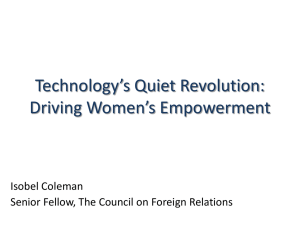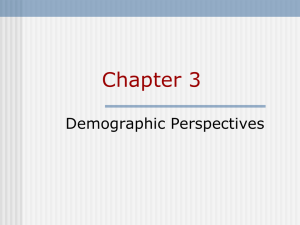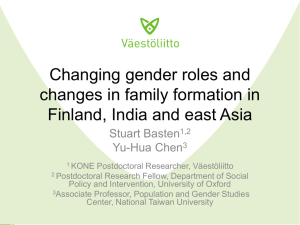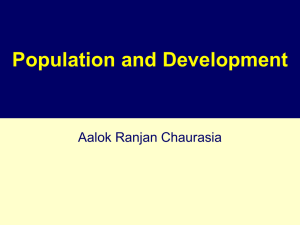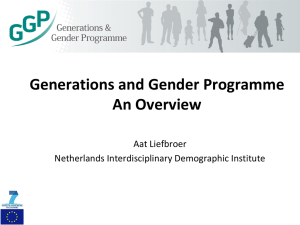European Fertility Project
advertisement
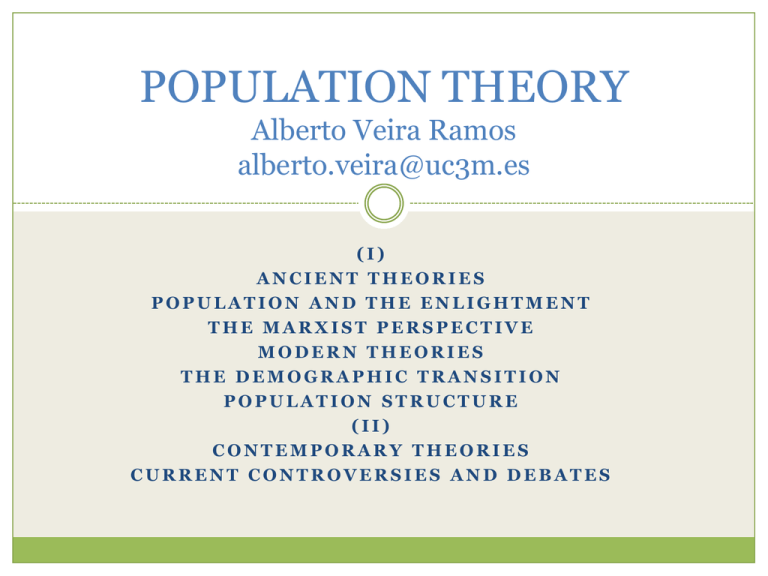
POPULATION THEORY Alberto Veira Ramos alberto.veira@uc3m.es (I) ANCIENT THEORIES POPULATION AND THE ENLIGHTMENT THE MARXIST PERSPECTIVE MODERN THEORIES THE DEMOGRAPHIC TRANSITION POPULATION STRUCTURE (II) CONTEMPORARY THEORIES CURRENT CONTROVERSIES AND DEBATES RECCOMENDED HANDBOOK A great deal of the materials presented in this course are from the book of Professor Jesús Javier Sánchez Barricarte “El Crecimiento de la Población Mundial” POPULATION THEORIES Population control as an old matter of concern in human societies Need for stimulating or controlling population growth Reasons: political military social economic ANCIENT CHINA Confucius (555-479 b.c.): All Chinese must worship the souls of ancestors by performing certain rites which only males can do Under high mortality regime, ensuring the survival of at least one male descendent to adult age requires for a family to have several children There is, however, an “optimal” number of people whom could live within a given territory It is the duty of the ruler to (re-) distribute population accordingly to this principle, if necessary, colonizing new lands ANCIENT GREECE Plato (428-348 b.c.) in The laws: Ideal de city-state: 5.040 families Authorities must regulate population growth Favoring immigration Favoring colonization Restricting number of births Aristotle (384-322 b.c.) in The policy: A great city is NOT an overcrowded city Too many people can cause social unrest Abortion and infanticide may be used if necessary ANCIENT ROME Roman Civilization (509 a.c.-395 b.c.): Demographic growth positive for militaristic expansion César Augusto enacted laws promoting natalism ANCIENT ARAB WORLD Ibn Jaldun (XIV century): High population density is a positive element It allows for a greater division of labor Demographic decline is a symptom of decadence RELIGIONS All major religions hold pro-natalistic views Hinduism Judaism Christianism Islam ANCIENT SCHOOLS OF THOUGHT Pro-natalist: Confucius More riches for the Emperor and settlement of new lands Romans military expansionism Ibn Jaldun Division of labor Preserve the “ideal size”: Preserve good governance and avoid social unrest Plato Immigration or colonization Aristote Abortion or infanticide THE ENLIGHTENMENT (SUMMARY) Mercantilism (XVI-XVIII): Power and wealth of the State (the King) increases along with production and export of manufactured goods More population entails more artisans and merchants Fisiocracy (XVIII France): Economic growth (and the welfare of the population) is limited by agriculture production Marquis de Condorcet: Science can favor “unlimited” growth of food production Families are capable of self-regulating their own reproduction Classic School of Economics (XVIII-XIX): Adam Smith, Thomas Malthus, David Ricardo y John Stuart Mill THE ENLIGHTENMENT Mercantilism (XVI - XVIII): Power and wealth depend on the accumulation of money and precious metals (gold and silver) A growing population… Higher division of labor (more artisans and merchants) More production and export of manufactures More revenues for the treasury May empoverish farmers and peasants but that has a positive effect because makes them to work harder (Sir William Temple) THE ENLIGHTENMENT Mercantilism (XVI - XVIII): Pronatalist policies: Favor marriage and large families Improve public health (to reduce mortality) Deter emigration (except to colonies) Promote immigration (especially highly qualified artisans and merchants) THE ENLIGHTENMENT Mercantilism (XVI - XVIII): Jean Baptiste Colbert (1619-1683): No taxes to those married aged 20 to 25 and to fathers of at least 10 children Sir William Temple (1628-1699): Demographic preassure is good against lazyness Sir William Petty (1623-1687): The prosperity of the Netherlands is due to its high population density Giovanni Botero (1543-1617): “Virtus generativa” (constant) and “virtus nutritiva” (sets the limits but can be increased) Luís Ortiz (XVI) y Sancho de Moncada (XVII): Alert about the negative consequences for Spain derived from the colonization of the Americas THE ENLIGHTENMENT Fisiocracy (XVIII): The true nature of wealth is not commerce but agriculture (François Quesnay, Jacques Turgot, Benjamin Franklin) Only increasing agriculture production population can increase Favorable to population growth providing agriculture production can increase accordingly Main goal of good government is to favor agriculture production THE ENLIGHTENMENT Nicolas de Caritat, Maquis de Condorcet (1723-1790): Technological progress has no limits Science may always provide the necessary means to increase agriculture productivity according to human needs Otherwise couples would voluntarily and smoothly would adapt to situation by lowering their fertility THE ENLIGHTENMENT Adam Smith (1723-1790): Demographic growth is the growth of human productive capacity It is the corner stone of progress and the division of labor, a key factor for the creation of wealth Reproductive behavior responds to the demand for labor: Higher demand implies higher salaries Higher salaries lead to earlier marriages and higher fertility Children contribute to the household wealth At some point, the focus of the most notorious intellectuals begins to shift From discussing how to increase the wealth of the nation to how to reduce the number of poor people POVERTY IN CITIES Slums (poverty) Slums (overcrowded houses) Slums (child poverty) THE ENLIGHTENMENT (social debate) John Stuart Mill (1806-1873): Working classes may reduce their fertility to prevent salaries from decreasing (conflict between common good and individual self-interest) David Ricardo (1772-1823): Poverty is caused by the economic system (rent income vs trade income) Thomas Malthus (1766-1834): Poverty is caused by the “law of diminishing returns” on agriculture (scarcity of food is unavoidable given limitless population growth) Thomas R. Malthus (1766-1834) Priest of the Church of England Professor of History and Economy Son of Thomas Daniel, an admirer of Condorcet and Godwin (both fisiocrats) who believed that technological progress is limitless Thomas R. Malthus (1766-1834) “An Essay on the Principle of Population” (1798) Refute the optimistic views of contemporary schools of thought Those who trust on self-regulation of human populations Those who trust on technological progress His thesis is based on three principles Food is necessary for the survival of humans The passion between the sexes is necessary and has never varied in the past nor will it do in the future Agricultural production is subject to the “law of diminishing returns” Thomas R. Malthus (1766-1834) The Passion between the sexes Human populations reproduce themselves in a way that they tend to grow exponentially (2, 4, 8, 16, 32...) The law of diminishing returns Food production increases arithmetically (1, 2, 3, 4, 5…) Adding more farmers to work on the fields does not contribute to increase food production accordingly Malthus established his “Principle of Population” as a natural and divine universal law: “The power of population is so superior to the power of the earth to produce subsistence for man, that premature death must in some shape or other visit the human race” Law of diminishing returns Law of diminishing returns Law of diminishing returns Malthusian trap Thomas R. Malthus (1766-1834) Two forces keep human populations beneath their limit: Positive checks increase mortality: famines, epidemics, pestilences, wars, natural catastrophes, malnutrition, unemployment, low salaries, extreme poverty, unhealthy living conditions Preventive checks derived from voluntary human action oriented to self-control abstinence and delay of age at marriage (the only morally acceptable ones for Malthus) Thomas R. Malthus (1766-1834) The true cause of human misery is A natural universal law: The principle of population It is not caused by the malfunction of human institutions which could be reformed (as Godwin, Condorcet or his own father believed) Neither the Society, nor salaries, nor God are responsible for the misery of the poor people The only ones to blame for their suffering are the poor themselves, for having reproduced irresponsibly People from working classes are not sufficiently motivated to exercise a responsible self-control on their reproduction Therefore, human growth is controlled mainly by wars, diseases and famines Thomas R. Malthus (1766-1834) He opposed the so called “poor laws” aimed at providing relief to the poor people Malthus believed that unless poor people experience all the hardships derived from their own reproductive decisions they would not change their behavior Public charity allows for poor people to continue reproducing themselves irresponsibly Charity and the “poor laws” Malthusianism today The law of diminishing returns on agriculture has been refuted, most particularly over the last quarter of the 20th century The Malthusian model applies only to underdeveloped societies, closed to technological innovation Amelioration of living conditions often brings increase on the number of poor people. Why? Malthus failed to notice that population increase was caused by the drop of (infant) mortality and not by the increase of fertility among poor people THE FALL OF MORTALITY Improvements in living conditions in cities Sanitation Control over water supply reduced the risk of cholera Cleaner streets and healthier habits Vaccination Lady Montagu’s “variolation” against small pox Edward Jenner’s “vaccination” against small pox The Balmis expedition Improvements on transportation Steam engine on trains and ships Improvements on food production Crops from other continents Sanitation in XVII-XVIII Sanitation Sanitation Sanitation Sanitation Sanitation Lady Montagu: variolation Edward Jenner: vaccination Cowpox and Smallpox The Balmis expedition Transportation THE FALL OF MORTALITY Mortality differential between cities and villages Mortality also decreases because of social development (not exclusively because of technical innovations) Tighter control of epidemic outbursts (effective enforcement of quarantines) The plague in Marseille Statistical surveys on causes of death in the Ottoman Empire Effects of wars are reduced by tighter discipline Napoleonic army codes burial of the death food in can, less plundering the land vaccination of soldiers Malthusian trap finally avoided? Malthusianism today Nowadays, however, neo-malthusians proclaim that the unlimited growth of human population is still a threat, because of the scarcity of natural resources http://www.youtube.com/watch?v=4V09jl5WIvw Law of diminishing returns at school THE MARXIST PERSPECTIVE Karl Marx (1818-1883): denied the existence of a natural law causing poverty among working classes There are no “general laws”; each system of production generates its owns Misery is not caused by an excessive number of people, rather it is caused by the capitalist system of production and private property The capitalist system has its own law concerning population: “Surplus population theory” THE MARXIST PERSPECTIVE Marx’s “surplus population theory” The worker sells the capitalist its labor and the capitalist pays a salary that is just above the subsistence level The salary represents only a fraction of the value derived from the worker’s work The “surplus” is kept by the capitalist Capitalists seek to maximize their profits To keep salaries down, the capitalist system requires large numbers of unemployed workers, the so called “reserve army of labor” Introduction of machinery allows capitalists to trim down their need for workers, making them redundant THE MARXIST PERSPECTIVE There is no overpopulation in relation to production but in relation to the number of jobs offered by the capitalists There is enough production (food and goods) for all There are not job for everyone, so not everyone can access to produced goods equally. This facilitates production accumulation by the capitalist class According to Marx, Malthus only defended the interests of landlords (the agricultural oligarchy) and the most conservative fraction of the bourgeoisie The increase in the number of poor people was the most eloquent consequence of the malfunctions of capitalism In a well organized communist society more people should mean more wealth, not more poverty Marx refutes the “law of diminishing returns” Orthodox socialists consider that fertility control is a bourgeois remedy against poverty and economic inequality (unlike Communist China nowadays) SOCIOLOGICAL THEORIES Those which emphasize the goods of demographic increase: Émile Durkheim (1858-1917) Eugène Gustave Dupréel (1879-1967) Those which argue that progress leads to decrease in fertility Arsène Dumont (1849-1902) Ludwig J. Brentano (1844-1931) SOCIOLOGICAL THEORIES Émile Durkheim (1858-1917): High population density is fundamental to stimulate progress It facilitates division of labor Mechanic solidarity Organic solidarity Division of labor grows at a faster pace if populations grow at a higher rate Industrialized societies have reached a higher division of labor (larger list of occupations and social classes) than primitive societies because they have a higher demographic density SOCIOLOGICAL THEORIES Eugène Gustave Dupréel (1879-1967): Population increase is the most decisive element for progress and modernization of a society Population growth stimulates competition and individual initiative Higher population density entails more “contacts” between individuals Population growth stimulates the development of new techniques and “inventions” aiming to increase production Absence of population growth produces economic and technological stagnation and deters entrepreneurial and innovative spirit SOCIOLOGICAL THEORIES Arsène Dumont (1849-1902): There are three population principles and not just one: The Malthusian model animals and primitive societies of hunters and gathers The Adam Smith model populations adjustment responds to available employment The “Social Capillarity” model couples have fewer children if opportunities for social mobility are higher. Fertility is higher in societies of rather rigid systems of social stratification SOCIOLOGICAL THEORIES Ludwig Joseph Brentano (1844-1931): The human being is a pleasure-seeking creature Poor people need motivation to reduce their fertility voluntarily The pleasure associated to having children may be replaced or combined with other pleasures Privileged classes have fewer children because they find available a more diverse variety of sources of pleasure Traveling, reading, esthetics, culture Focus more on quality rather than on quantity Social reproduction Drop of fertility occurs when progress makes available new forms of pleasure to larger numbers of people (Uwaga!: for some industrial workers having more children was the rational thing to do) MATHEMATICAL THEORIES Exponential growth model Logistic curve model Edward Deevey logarithmic scale model MATHEMATICAL THEORIES Exponential (geometric) growth model: Growth is limitless and growth rate is constant over time Population doubles itself faster Population growth after the industrial revolution seems to fit to this type of growth In truth such model is adequate to make population forecasts for one or two decades Population growth Population growth Population growth 7,000 6,000 5,000 4,000 3,000 2,000 1,000 0 MATHEMATICAL THEORIES Logistic curve model: High growth rate at the beginning Growth slows down after reaching a certain point Growth decelerates as population approaches a certain “limit” Population growth and yearly growth rates 2.50 8,000 7,047 2.22 2.00 6,854 2.00 1.98 1.86 6,057 1.53 5,255 1.50 1.32 7,000 6,000 1.41 5,000 4,430 1.13 1.00 4,000 3,691 % anual 2,000 1,613 0.070.080.06 1,243 Población 1,000 968 2,012 2,010 2,000 1,990 1,980 1,970 1,960 0 1,850 1,800 1,750 1,700 1,600 1,500 1,400 1,340 1,300 1,250 -0.25 580 682 775 429 439 374 458 413 399 301 1,200 1,100 1,000 900 800 700 600 500 200 400 223 250 255 204 205 211 210 227 227 257 0.27 0.220.27 0.18 1,900 0.08 0.06 0.01 0.000.030.00 0.00 -0.10 1 -200 -500 -400 -1,000 -2,000 152 20 40 60 100 80 100 -3,000 6 -4,000 -10,000 -0.50 -5,000 0.10 0.050.07 0.05 0.05 0.00 -0.02 0.130.17 1,950 0.33 0.23 0.00 3,000 3,020 0.570.60 0.50 2,521 0.52 0.50 Population growth and projections MATHEMATICAL THEORIES Edward Deevey (1914-1988): Deevey used logarithmic scales to plot human population growth over time Growth patterns show three landmarks in human history: Paleolithic revolution about 1 million years ago Neolithic revolution about 10.000 years ago Industrial revolution (1750-) MATHEMATICAL THEORIES Edward Deevey(1914-1988): Humans have always pushed upwards the carrying capacity of our environment by developing new technologies Contrary to what Malthus said, human population growth is not constant over time Technological and social advancements and improvements cause an increase on demographic growth after they are implemented but growth slows down gradually as populations reach the limit set by those improvements and economic conditions Edward Deevey’s model of logarithmic scale Population growth I (Paleolithic and Neolithic) 20 18 16 8000 A.C.: Holocene End of last glacial period (Würm) Higher sea level 14 12 10 Human populations affected by climate changes 8 6 Paleolithic revolution Neolithic revolution 4 2 0 -100,000 -40,000 -35,000 -30,000 -25,000 -20,000 -15,000 -10,000 -5,000 Population growth I (Rise of ancient civilizations) Population growth II (Global trade) 1,000 900 800 700 1315-17: Little iceage. Bad crops in Europe 600 1337: the 100 years war 500 1348-75: The Plague S. X-XIII: End of the Dark Ages, cultural renaissance in various areas of the world 400 300 200 100 1760 A.C.: Hammurabi code (first written laws) Diffusion of agriculture Apogeo y crisis de las grandes civilizaciones clásicas: Mesopotamia, China, Egipto, India, Persia, Grecia, Roma Age of metals: wars 0 476-1000: Dark Ages, numerous invasions 1750-1850: The industrial Revolution S.XVII-XVIII: The Enlightenment and the Scientific 1200-1300: Mongol invasions 950-1250: Warm climate due to increasing solar activity (Vikings in Greenland) S. XV-XVI: Transoceanic commerce Population growth III (Industrial revolution) 8,000 7,000 1800-2000: Population X6 in 200 years 6,000 1950 -2012: Population increases in 4.500 millions after decolonization 5,000 4,000 3,000 1960-2011: Population grows from 3.000 to 7.000 millions (4.000 millions in half a century) 2,000 1,000 275 millions in 50 years 908 millions in 50 years 370 millions in 50 years 0 1,800 1,850 1,900 670 millions in 10 years 500 millions in 10 years 1,950 1,960 825 millions in 10 years 740 millions in 10 years 1,970 1,980 797 millions in 10 years 802 millions in 10 years 1,990 2,000 2,010 2,012 Controversy regarding population growth Population growth entails social problems and may be regarded as a problem for the future Aristotle, Malthus, Marxists –China- Population growth is the engine of economic and social development because it allows for a more intense division of labor Mercantilism, Adam Smith, Marx, Durkheim, Dupréel Population growth is a consequence of technological and social development Edward Deevey Controversy regarding population growth Demographic growth must be limited Malthus, China Demographic growth must be stimulated Mercantilism, France Populations regulate themselves and no direct intervention from the state is required Adam Smith salaries y market Dumont y Brentano social mobility and social reproduction (Uwaga!: for some industrial workers having more children was the rational thing to do) THE DEMOGRAPHIC TRANSITION Adolphe Landry (1874-1956): 1909. "Les trois théories de la population." Revue Scientia. 1934. La révolution démographique. Paris: Sirey. Warren Thompson (1887–1973): Thompson, W.S. (1929), "Population" American Sociological Review 34 (6): 959-975. Frank Notestein (1902-1983): Notestein, F.W. (1945), "Population - The long view." in Schultz, Theodore William -Ed-, Food for the world, Chicago, University of Chicago Press, pp. 36-57. Notestein, F.W. (1953), "Economic problems of population change." Presented at Eight International Conference of Agricultural Economists, London. THE DEMOGRAPHIC TRANSITION The Demographic transition theory became popular among politicians after the second world war, because of the geopolitical changes that took place following the emancipation of large areas of Africa and Asia Can the European experience be a model for what may happen in third world countries? The European Fertility Project at the Princeton University http://opr.princeton.edu/archive/pefp/ The European Fertility Project: The European Fertility Project at the Princeton University (http://opr.princeton.edu/archive/pefp/) The most ambitious research project in social sciences up to then and the first to make use of computers It purpose is to test the validity of the DT model Information on 1.229 European regions was gathered from periods ranging from mid 19th century to the mid 20th century During the 70’s and 80’s a great deal of information was generated and analyzed and new tools for demographic analysis were developed and implemented The European Fertility Project: The project revealed that there were some inconsistencies between theory and the actual facts Starting dates of the transition do not always coincide with those of the industrial revolution France Mortality and Fertility decline started before industrialization England Fertility decline started when industrialization was way in progress The relevance of migratory flows between continents Ireland High migration outflows kept fertility high USA Fertility declined faster than Mortality. Population grew thanks to immigration (immigrants tend to have lower fertility) The European Fertility Project: The project revealed that there were some inconsistencies between theory and the actual facts Starting dates do not coincide with industrialization, urbanization or modernization of the economy Initial levels of mortality and fertility may vary Final levels after completing the transition may not be the same in all countries or regions Importance of late marriage in Europe Many countries reach fertility rates below generational replacement levels The “speed” at which the transition takes place may vary This is the period during which populations grow dramatically, if its length cannot be predicted the theory has little practical value The European Fertility Project: The project revealed that there were some inconsistencies between theory and the actual facts There is no agreement on which are the mechanisms that operate driving the transition “tempo” Kingsley Davis: Fertility responds to mortality Frank Notestein: Both fertility and mortality respond to economic change and urbanization The European Fertility Project: New contributions to implement the DT model Ansley Coale (1973) and the “Necessary Conditions” Fertility must be dependent from individual decisions The cost-benefit of childbearing must shift Caldwell (1976) and the “Wealth Flows” End of child labor and mandatory schooling Women at paid work (women vs children’s salaries) Ron Lesthaeghe (1945-) y D. J. van de Kaa (1933-) and the “Second Demographic Transition” (1986) Fertility permanently below replacement levels Delayed marriage (no longer universal due to increase on cohabitation) and increase of divorce rates and second marriages Changes in values lead to smaller sized households THE DEMOGRAPHIC TRANSITION POPULATION STRUCTURE POPULATION STRUCTURE POPULATION STRUCTURE POPULATION STRUCTURE POPULATION STRUCTURE http://www.insee.fr/fr/themes/detail.asp?ref_id=irsd2009&page=irweb/sd2009/dd/pyramide/pyramide_aide.htm RUSSIA 1998 UNITED KINGDOM 2007 GERMANY 2009 Mortality and Fertility in Spain: 1858-1998 Population pyramids of Spain 1960 and 2001 PRACTICAL EXERCISE When did the demographic transition started to occur in Poland? Decline of mortality Decline of fertility How long did it last? (when was it completed?) How has the population pyramid of Poland has changed over time? At which stage of the Demographic transition is Poland today? Explain why. Data on Poland http://populationpyramid.net/poland/2015/ http://www.indexmundi.com/poland/age_structure .html http://www.worldlifeexpectancy.com/polandpopulation-pyramid http://www.nationmaster.com/countryinfo/profiles/Poland/People Etc.





